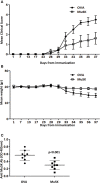MuSK EAMG: Immunological Characterization and Suppression by Induction of Oral Tolerance
- PMID: 32256489
- PMCID: PMC7089875
- DOI: 10.3389/fimmu.2020.00403
MuSK EAMG: Immunological Characterization and Suppression by Induction of Oral Tolerance
Abstract
Myasthenia gravis (MG) with antibodies to the muscle-specific receptor tyrosine kinase (MuSK) is a distinct sub-group of MG, affecting 5-8% of all MG patients. MuSK, a receptor tyrosine kinase, is expressed at the neuromuscular junctions (NMJs) from the earliest stages of synaptogenesis and plays a crucial role in the development and maintenance of the NMJ. MuSK-MG patients are more severely affected and more refractory to treatments currently used for MG. Most patients require long-term immunosuppression, stressing the need for improved treatments. Ideally, preferred treatments should specifically delete the antigen-specific autoimmune response, without affecting the entire immune system. Mucosal tolerance, induced by oral or nasal administration of an auto-antigen through the mucosal system, resulting in an antigen-specific immunological systemic hyporesponsiveness, might be considered as a treatment of choice for MuSK-MG. In the present study we have characterized several immunological parameters of murine MuSK-EAMG and have employed induction of oral tolerance in mouse MuSK-EAMG, by feeding with a recombinant MuSK protein one week before disease induction. Such a treatment has been shown to attenuate MuSK-EAMG. Both induction and progression of disease were ameliorated following oral treatment with the recombinant MuSK fragment, as indicated by lower clinical scores and lower anti-MuSK antibody titers.
Keywords: T regulatory cells; muscle-specific receptor tyrosine kinase (MuSK); myasthenia gravis; neuromuscular junction (NMJ); oral tolerance.
Copyright © 2020 Reuveni, Aricha, Souroujon and Fuchs.
Figures





Similar articles
-
Effects of Teriflunomide on B Cell Subsets in MuSK-Induced Experimental Autoimmune Myasthenia Gravis and Multiple Sclerosis.Immunol Invest. 2021 Aug;50(6):671-684. doi: 10.1080/08820139.2020.1785491. Epub 2020 Jun 29. Immunol Invest. 2021. PMID: 32597289 Clinical Trial.
-
Active Immunization for Inducing Autoimmune Muscle-Specific Kinase (MuSK) Myasthenia Gravis in Mice.J Vis Exp. 2025 Jul 3;(221). doi: 10.3791/67408. J Vis Exp. 2025. PMID: 40690397
-
Antibodies against muscle-specific kinase impair both presynaptic and postsynaptic functions in a murine model of myasthenia gravis.Am J Pathol. 2012 Feb;180(2):798-810. doi: 10.1016/j.ajpath.2011.10.031. Epub 2011 Dec 3. Am J Pathol. 2012. PMID: 22142810
-
Clinical and scientific aspects of muscle-specific tyrosine kinase-related myasthenia gravis.Curr Opin Neurol. 2014 Oct;27(5):558-65. doi: 10.1097/WCO.0000000000000136. Curr Opin Neurol. 2014. PMID: 25159928 Review.
-
Introducing Autoimmunity at the Synapse by a Novel Animal Model of Experimental Autoimmune Myasthenia Gravis.Neuroscience. 2018 Mar 15;374:264-270. doi: 10.1016/j.neuroscience.2018.01.042. Epub 2018 Feb 6. Neuroscience. 2018. PMID: 29421431 Review.
Cited by
-
IgG4 Autoantibodies in Organ-Specific Autoimmunopathies: Reviewing Class Switching, Antibody-Producing Cells, and Specific Immunotherapies.Front Immunol. 2022 Mar 24;13:834342. doi: 10.3389/fimmu.2022.834342. eCollection 2022. Front Immunol. 2022. PMID: 35401530 Free PMC article. Review.
-
Myasthenia Gravis: Autoantibody Specificities and Their Role in MG Management.Front Neurol. 2020 Nov 30;11:596981. doi: 10.3389/fneur.2020.596981. eCollection 2020. Front Neurol. 2020. PMID: 33329350 Free PMC article. Review.
-
Immunoregulatory Cells in Myasthenia Gravis.Front Neurol. 2020 Dec 15;11:593431. doi: 10.3389/fneur.2020.593431. eCollection 2020. Front Neurol. 2020. PMID: 33384654 Free PMC article. Review.
-
Recombinant Acetylcholine Receptor Immunization Induces a Robust Model of Experimental Autoimmune Myasthenia Gravis in Mice.Cells. 2024 Mar 14;13(6):508. doi: 10.3390/cells13060508. Cells. 2024. PMID: 38534352 Free PMC article.
References
Publication types
MeSH terms
Substances
LinkOut - more resources
Full Text Sources
Medical

